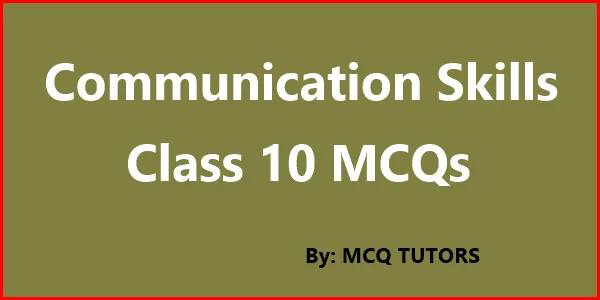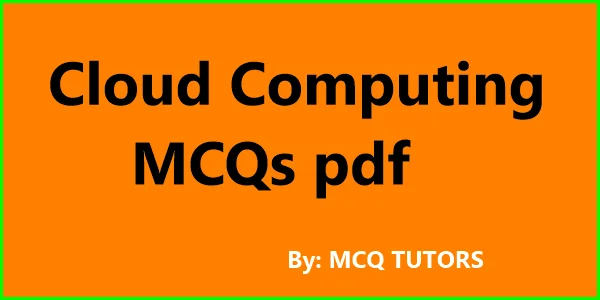Mobile Computing and Application Development MCQ with Answers for the preparation of MCA, BCA & other IT Exams, also useful for competitive exams.
Are you looking for an easy and efficient way to prepare for Mobile Computing and Application Development MCQs? This article provides a comprehensive set of MCQs related to Mobile Computing and Application Development.
It is designed to help students, professionals, and anyone interested in this field to review and test their knowledge. With these MCQs, you can easily assess your understanding of the subject matter.
Mobile Computing and Application Development MCQs
1. ___ is used mainly for analog transmission.
A. Frequency Division Multiple Access
B. Time Division Multiple Access
C. Code Division Multiple Access
D. System Identification Code
Answer: A
2. Cellular networks use the concept of ___.
A. Doubling of frequency
B. Half-power frequency
C. Frequency Re-use
D. Multiple Frequencies
Answer: C
3. Identify the basic radio network architectures from the following:
A. Indirect Networks
B. Dual site Networks
C. Single Homed Networks
D. Cellular Networks
Answer: D
4. ___ is a result of the absorption of radio waves by leaves and other vegetation.
A. Noise
B. Fading
C. Foliage loss
D. Interference
Answer: C
5. A subscription is usually linked with a home PLMN. What does PLMN stand for?
A. Public Land Main Network
B. Public Land Mobile Network
C. Primary Local Mobile Network
D. Private Local Mobile Network
Answer: B
6. Which of the following parts of a cellular system correspond to a mobile telephone?
A. Cell site
B. Mobile unit
C. Control unit
D. MTSO
Answer: B
7. The first commercial GSM system was implemented in which country?
A. China
B. Russia
C. America
D. Germany
Answer: D
8. The high mobile cellular base station antennas introduce ___ of a few orders of magnitude larger than in cordless telephone applications.
A. Transmission power
B. Orthogonal Signals
C. Delay spreads
D. Bandwidth loss
Answer: C
9. Which systems are often called spread-spectrum systems?
A. Frequency division multiple access systems
B. Code division multiple access systems
C. Time-division multiple access systems
D. Wireless communication systems
Answer: B
10. Which of the following methods are employed to improve the robustness of channel fading is TDMA?
A. Fast frequency hopping
B. Antenna uniformity
C. Slow frequency hopping
D. Direct sequence spreading
Answer: C
11. Guard time of ___ between time slots are commonly used in TDMA-based systems.
A. 10 seconds
B. 30–50 microseconds
C. 1 minute
D. 40–60 milliseconds
Answer: B
12. Which of the following are the domains commonly available in wireless communication?
A. Transmission domain
B. Space domain
C. Time domain
D. Spectrum domain
Answer: C
13. According to the technical specifications, GPRS supports transmission data rate upto ___.
A. 114kbps
B. 115kbps
C. 117kbps
D. 116kbps
Answer: B
14. ___ are extensions of the Public Switched Telephone Network.
A. Wireless LANs
B. Point-to-Point WANs
C. Cellular WANs
D. Single site LANs
Answer: C
15. Base stations use a special ___ network for data transmissions.
A. Backhaul
B. Front haul
C. Gateway
D. Air link
Answer: A
16. Which of the following are examples of Mobile wireless systems?
A. Traditional over-air broadcast TV
B. Microwave backhaul networks
C. Pager
D. Direct to home satellite service
Answer: C
17. Which of the following wireless network covers a large geographical area?
A. Personal area network
B. Local area network
C. Metropolitan area network
D. Wide area network
Answer: D
18. In order to increase the capacity for data transmission, ___ works by concatenating two or more telephone calls.
A. Terrestrial Trunked Radio
B. 1 extreme Radio Transmission
C. General Packet Radio Service
D. High-Speed Circuit Switched Data
Answer: D
19. The___ standards group chose OFDM modulation for wireless LANs operating at bit rates up to 54Mbs−1 at 5 GHz.
A. IEEE 802.11
B. IEEE 804
C. IEEE 803.11
D. IEEE 702.11
Answer: A
20. ___ allows individual channels to maintain their orthogonality or distance to adjacent channels.
A. DHCP
B. OFDM
C. TCPIP
D. IP
Answer: B
21. Which of the following is helpful to provide support for workgroups?
A. Virtual LANs
B. LAN
C. WAN
D. VAN
Answer: A
22. In the HAMAC protocol, the uplink frame consists of___ segments.
A. Three
B. Two
C. Four
D. Five
Answer: A
23. ___ transmissions are controlled according to assigned QoS.
A. Frame queuing
B. ARQ
C. Both a and b
D. FEC
Answer: C
24. Which of the following type of protocol is cannot be used for mobile ad hoc networks?
A. Adhoc networks
B. Mobile networks
C. Routing protocols
D. DHSS
Answer: C
25. ___ is an adoption of a conventional routing protocol to ad hoc networks.
A. FHSS
B. DSDV
C. CGI
D. DHSS
Answer: B
26. Each node in the network maintains ___.
A. Distance table
B. RT
C. Link-cost table
D. All of the above
Answer: D
27. According to ISDN terminology, the GSM signaling channels are also known as ___ channels.
A. Networking
B. DM channel
C. CCCH channel
D. DCCH channel
Answer: B
28. The BCCH is broadcast on the first frequency assigned to the cell, so it is called ___.
A. Carrier
B. BCH carrier
C. BCCH carrier
D. CCCH carrier
Answer: C
29. ___ is helpful to store authentication information of the users.
A. GSM
B. AUC
C. HLR
D. GMSC
Answer: B
30. Which of the following databases are helpful to store the current location of a mobile user?
A. HLR
B. VLR
C. Both a and b
D. GMSC
Answer: C
31. Which of the following is the major limitation with any radio system?
A. Networking
B. Available bandwidth
C. Programming languages
D. Separate frequencies
Answer: B
32. Which of the following brands are available for use by license-free transmitters?
A. 902 to 928 MHz
B. 2.4 to 2.5 GHz
C. 5.7 to 5.8 GHz
D. All of the above
Answer: D
33. IEEE 802.11 architecture handles ___.
A. Multiple logical media
B. Address spaces
C. Both a and b
D. Wireless devices
Answer: C
34. The ___ signals travel through walls and communicate where there is no direct path between the terminals.
A. ISM
B. RF
C. SS
D. MTs
Answer: B
35. Which of the following are the classes of ad hoc routing protocols?
A. Table driven
B. On-demand routing
C. Both a and b
D. Ad hoc protocol
Answer: C
36. DSDV is mainly based on ___.
A. Networking
B. RIP
C. RT
D. None of the above
Answer: B
37. Which of the following is similar to DSDV?
A. WML
B. GSR
C. LTs
D. RTs
Answer: B
38. Infrastructure network consists of a network with ___ gateways.
A. Fixed
B. Wired
C. Both a and b
D. Unfixed
Answer: C
39. Which of the following is a table-based distance vector routing protocol?
A. Ad hoc network
B. WRP
C. WAN
D. LAN
Answer: B
40. In IEEE 802.11 the addressable unit is a ___.
A. Station
B. JavaScript
C. Code
D. Tag
Answer: A
41. The way in which signals are transmitted and received between radio devices is called ___.
A. Dual mode
B. Hand-off
C. Communication Modes
D. Cellular mode
Answer: C
42. Which of the following is a segment of the cellular network?
A. Home Location
B. Public Switched Telephone Network
C. Remote host space
D. Backhaul
Answer: D
43. ___is an example of a half-duplex network.
A. Walkie-talkie
B. Mobile phone service
C. Broadcast radio network
D. Unicast radio network
Answer: A
44. Whenever a mobile unit wishes to set up a call, it contacts ___ of the particular cell in which it exists at that instant.
A. Mobile Telephone Switching Office
B. Base Station Subsystem
C. Public Switched Telephone Network
D. Cell Site
Answer: D
45. Each time slot of a voice channel contains ___ per block.
A. 860 bits
B. 260 bits
C. 560 bits
D. 50 bits
Answer: B
46. The main purpose of DHCP is to provide___.
A. Hosts with addresses
B. Configuration information
C. Both a and b
D. Selling
Answer: C
47. ___is based on the properties of an OFDM physical layer.
A. UMTS
B. DPA
C. WCDMA
D. OFDM
Answer: B
48. The WAP specifications extend and leverage the internet technologies like___.
A. IP
B. HTTP
C. XML
D. A, B, and C
Answer: D
49. The mobile wireless environment is characterized by a very wide range of___.
A. Network
B. Network latency
C. Latency
D. Mobile devices
Answer: B
50. ___is written in RDF, W3C’s language for modeling metadata, descriptive information about items on the Web.
A. CC
B. LAN
C. WAN
D. VAN
Answer: A
Conclusion
Mobile Computing and Application Development MCQs are an essential tool for those looking to increase their knowledge of the subject. The questions presented here provide a comprehensive overview of the material, covering topics from the basics to more advanced concepts.
Thanks for visiting our website, if you like the post on Mobile Computing and Application Development MCQ, please don’t forget to share on social media.
Read More:




